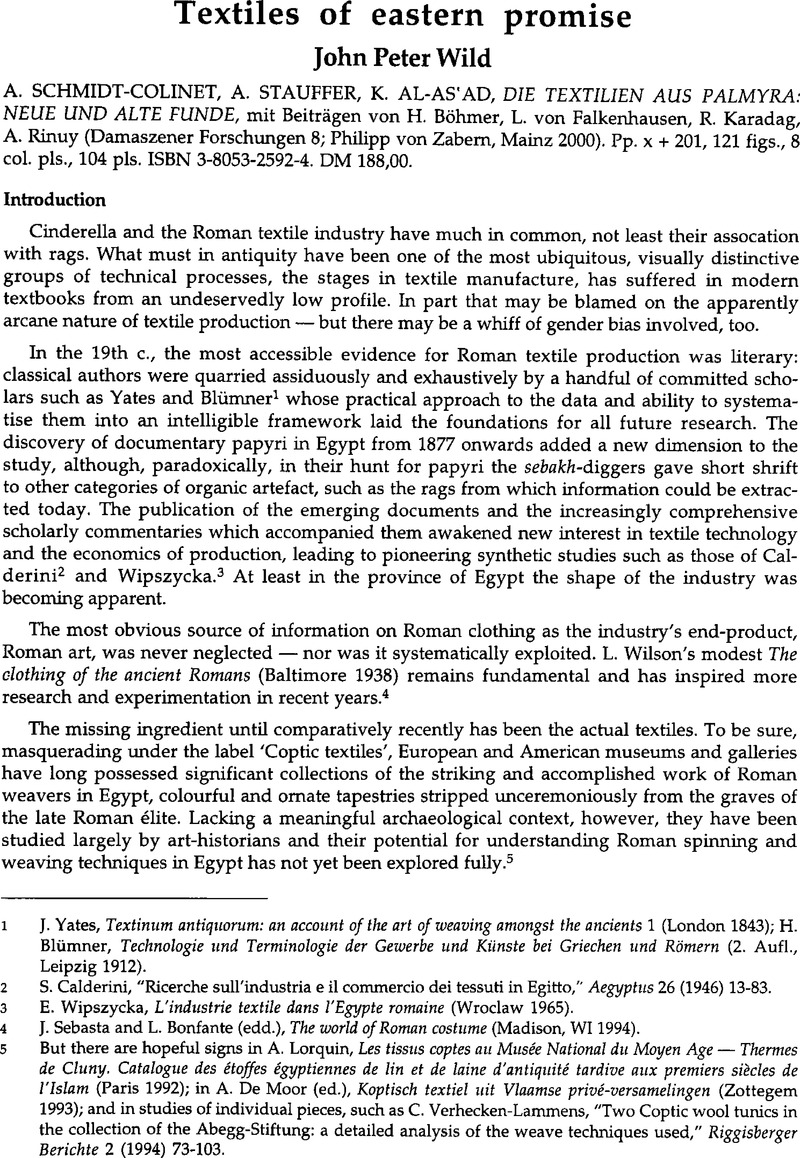No CrossRef data available.
Article contents
Textiles of eastern promise - A. Schmidt-Colinet, A. Stauffer, K. Al-As'ad, DIE TEXTILIEN AUS PALMYRA: NEUE UND ALTE FUNDE, mit Beiträgen von H. Böhmer, L. von Falkenhausen, R. Karadag, A. Rinuy (Damaszener Forschungen 8; Philipp von Zabem, Mainz 2000). Pp. x + 201, 121 figs., 8 col. pls., 104 pls. ISBN 3-8053-2592-4. DM 188,00.
Published online by Cambridge University Press: 16 February 2015
Abstract

- Type
- Reviews
- Information
- Copyright
- Copyright © Journal of Roman Archaeology L.L.C. 2002
References
1 Yates, J., Textinum antiquorum: an account of the art of weaving amongst the ancients 1 (London 1843)Google Scholar; Blümner, H., Technologie und Terminologie der Gewerbe und Künste bei Griechen und Römern (2. Aufl., Leipzig 1912)Google Scholar.
2 Calderini, S., “Ricerche sull'industria e il commercio dei tessuti in Egitto,” Aegyptus 26 (1946) 13–83 Google Scholar.
3 Wipszycka, E., L'industrie textile dans l'Egypte romaine (Wroclaw 1965)Google Scholar.
4 Sebasta, J. and Bonfante, L. (edd.), The world of Roman costume (Madison, WI 1994)Google Scholar.
5 But there are hopeful signs in Lorquin, A., Les tissus coptes au Musée National du Moyen Age — Thermes de Cluny. Catalogue des étoffes égyptiennes de lin et de laine d'antiquité tardive aux premiers siècles de l'Islam (Paris 1992)Google Scholar; in Moor, A. De (ed.), Koptisch textiel uit Vlaamse privé-versamelingen (Zottegem 1993)Google Scholar; and in studies of individual pieces, such as Verhecken-Lammens, C., “Two Coptic wool tunics in the collection of the Abegg-Stiftung: a detailed analysis of the weave techniques used,” Riggisberger Berichte 2 (1994) 73–103 Google Scholar.
6 Wild, J. P., “Vindolanda 1985-1988: the textiles,” in Birley, R. E. (ed.), Vindolanda 3: preliminary reports on the leather, textiles, environmental evidence and dendrochronology (Bardem Mill 1993) 76–90 Google Scholar.
7 Wild, J. P., Textiles in archaeology (Aylesbury 1988) 7–12 Google Scholar.
8 Stauffer, A., “The textiles of Palmyra: technical analyses and their evidence for textile research”, in Cardon, D. and Feugère, M. (edd.), Archéologie des textiles des origines au Ve siècle: Actes du colloque de Lattes 1999 (Montagnac 2000) 247–52Google Scholar.
9 Pfister, R., Textiles de Palmyre (Paris 1934)Google Scholar; Nouveaux textiles de Palmyre (Paris 1937)Google Scholar; Textiles de Palmyre III (Paris 1940)Google Scholar.
10 The whole question of ‘cashmere’ and ‘mohair’ in antiquity needs re-examination. For ‘cashmere’: C. Moulherat and G. Vial, “Première attestation d'un tissu en laine de chèvre cachemire en Gaule”, in Cardon and Feugère (supra n.8) 107-13; Debaine-Francfort, C. and Idriss, A., Keriya; mémoires d'un fleuve: archéologie et civilisation des oasis du Taklamakan (Paris 2001) 146–47, figs. 4-6Google Scholar; for ‘mohair’, see Hall, R. M., “Garments in the Petrie Museum of Egyptian Archaeology,” Textile History 13 (1982) 27-45, esp. 41 CrossRefGoogle Scholar.
11 Pace Schmitter, M.-T., “Subsericae vestes,” RA 1937, 201–25Google Scholar.
12 Wild, J. P., “Cotton in Roman Egypt: some problems of origin,” Al-Rāfidān 18 (1997) 287–98Google Scholar.
13 Granger-Taylor, H., “The grouping of warp threads for areas of weft-faced decoration in textiles of the Roman period: a means of distinguishing looms?” Vlaamse Vereniging voor oud en hedendaags textiel Bulletin 1992, 18–28 Google Scholar.
14 Pace my own “The Roman horizontal loom,” AJA 91 (1987) 459–71CrossRefGoogle Scholar.
15 Thompson, J. and Granger-Taylor, H., “The Persian zilu loom of Meybod,” Bulletin du Centre Int. d'Etude des Textiles Anciens 73 (1995–1996) 27–53 Google Scholar.
16 Cardon, D., “Les damassés de laine de Krokodilo (100-120 apr. J.C.),” Bulletin du Centre Int. d'Etude des Textiles Anciens 76 (1999) 6–21, with refs.Google Scholar; ead., “On the road to Berenike: a piece of tunic in damask weave from Didymoi,” in Rogers, P. Walton, Jørgensen, L. Bender and Rast-Eicher, A. (edd.). The Roman textile industry and its influence: a birthday tribute to John Peter Wild (Oxford 2001) 12–20 Google Scholar.
17 Pfister, R., Nouveaux textiles de Palmyre (Paris 1937) 24–25 Google Scholar; cf. Nockert, M., “Vid sidenvägens ände: textilier från Palmyra till Birka,” in Palmyra: öknens drottning (Stockholm 1988) 84–85 Google Scholar.
18 Jorgensen, L. Bender and Vogelsang-Eastwood, G., “The Abu Sha'ar textiles,” Archaeological Textiles Newsletter 11 (1990) 5 Google Scholar; Wild, J. P. and F. C. Wild, “The textiles”, in Sidebotham, S. E. and Wendrich, W. Z. (edd.), Berenike 98: Report of the 1998 excavations at Berenike and the survey of the Egyptian Eastern Desert (Leiden 2000) 251-74, esp. 259 Google Scholar.
19 Pfister's weaving draft of his L43 (Pfister 1937 [supra n.17] 24, fig. 8) shows displacement in both warp and weft; drafts of both L43 and L44 in Nockert (supra n.17) 84-85, fig. 62 (warp horizontal) and fig. 65 (warp vertical), indicate, perhaps more plausibly, displacement in warp but point repeat in weft. There is now some difficulty in identifying and distinguishing Pfister's L43 and L44: though very fine, both have considerable internal variability and weaving faults. They might even be the same fabric.
20 Wild, J. P., “Clothing in the north-west provinces of the Roman Empire,” BJb 168 (1968) 166–240, esp. 181-82, 193 with refsGoogle Scholar.
21 F. Pritchard and C. Verhecken-Lammens, “Two wide-sleeved linen tunics from Roman Egypt,” in Walton Rogers et al. (supra n.16) 24-29, where the parallel with cat. no. 355 (= Pfister's T20) is noted.
22 Wild and Wild (supra n.18) 265-70, with refs.
23 Gregory of Tours, Liber in Gloria Martyrum 17.
24 Millar, F., “Caravan cities in the Roman Near East and long distance trade by land,” in Austin, M., Harries, J. and Smith, C. (edd.), Modus operandi. Essays in honour of Geoffrey Kickman (London 1998) 119–37Google Scholar.
25 Periplus Maris Erythraei 39, 49, 56, 64.
26 Lac (as tablets?): Periplus Maris Erythraei 6; madder as dried root: Hall, A. R. et al., “Dyeplants in Viking York,” Antiquity 58 (1984) 58–60 Google Scholar.




